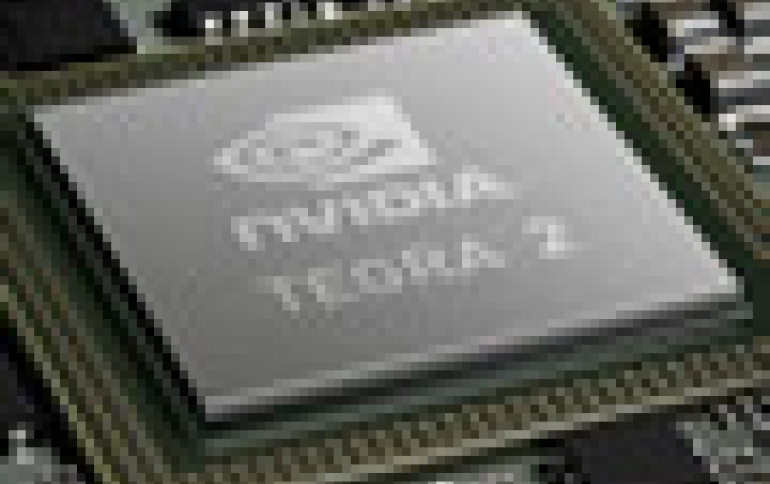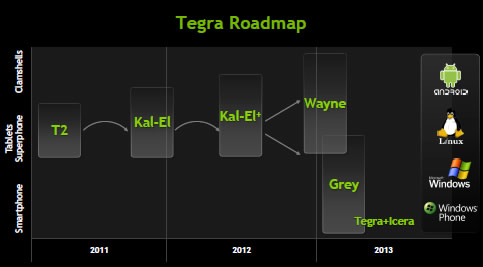
Nvidia Details Its Mobile Chip Strategy Powered by Tegra Chips
Nvidia is currently reinventing itself around mobile chips and graphics cards, with the company's first quad-core tablets powered Tegra processors to arrive this fall, followed by with quad-core smartphones early next year, the company said.
Samples of Nvidia's quad-core Tegra codenamed "Kal-El" has been already delivered to manufacturers, said Nvidia Chief Executive Officer Jen-Hsun Huang at the Citi Global Technology Conference earlier this week.
Nvidia's dual-core Tegra chips will power 2 tablet models by Q4 2011, and will reach the 8 models in Q1 2011 and 13 models in Q2 2012, Huang added.

By 2013, Nvidia is expected to leverage its acquisition of Icera to include 3G/4G modems with its Tegra chips, while the third prong is to develop a chip specifically optimized for Windows 8, Huang said.
Last June, however, Nvidia began offering OEMs the two main processors used in all smartphones -- an applications processor and the baseband processor.
According to Nvidia Senior Vice President Phil Carmack, the combined offering of a Tegra chip with Icera's 3G/4G modem is expected to open up the $15 billion global market for baseband processors to Nvidia.


Nvidia's "Wayne" Tegra SoC will succeed the upcoming Kal El. Wayne is projected to be made using 28nm process technology and will appear in 2012.
Nvidia's long-term strategy includes the development of a single tiny chip that integrates Icera's 3G/4G modem with the company's Tegra processor, according to Huang.
Nvidia will also try to take advantage of the upcoming platforms running Microsoft's Windows 8 operating system. Nvidia is developing the Kal-El + (Plus) Tegra chip that will be designed for Windows 8 OS.
Kal-El Plus will be also found in clamshell notebooks as well as in mobile handsets and media tablets equipped with processors based on the ARM architecture.
Nvidia has stopped making chipsets with integrated graphics for PCs after the company's dispute with Intel. Intel and Nvidia in January settled a long-standing legal dispute when the companies signed a patent cross-licensing agreement in January. Intel agreed to pay Nvidia $1.5 billion, and the companies got licenses to each other's patents. However, Nvidia will continue working with Intel in the discrete graphics card market. Intel is integrating its own graphics processor inside CPUs, but Nvidia's discrete graphics cards can work with Intel's chips to improve PC graphics.
The company plans to also grow its graphics market by expanding into new areas beyond the PC, such as servers and supercomputing, Huang said.

Nvidia's dual-core Tegra chips will power 2 tablet models by Q4 2011, and will reach the 8 models in Q1 2011 and 13 models in Q2 2012, Huang added.

By 2013, Nvidia is expected to leverage its acquisition of Icera to include 3G/4G modems with its Tegra chips, while the third prong is to develop a chip specifically optimized for Windows 8, Huang said.
Last June, however, Nvidia began offering OEMs the two main processors used in all smartphones -- an applications processor and the baseband processor.
According to Nvidia Senior Vice President Phil Carmack, the combined offering of a Tegra chip with Icera's 3G/4G modem is expected to open up the $15 billion global market for baseband processors to Nvidia.


Nvidia's "Wayne" Tegra SoC will succeed the upcoming Kal El. Wayne is projected to be made using 28nm process technology and will appear in 2012.
Nvidia's long-term strategy includes the development of a single tiny chip that integrates Icera's 3G/4G modem with the company's Tegra processor, according to Huang.
Nvidia will also try to take advantage of the upcoming platforms running Microsoft's Windows 8 operating system. Nvidia is developing the Kal-El + (Plus) Tegra chip that will be designed for Windows 8 OS.
Kal-El Plus will be also found in clamshell notebooks as well as in mobile handsets and media tablets equipped with processors based on the ARM architecture.
Nvidia has stopped making chipsets with integrated graphics for PCs after the company's dispute with Intel. Intel and Nvidia in January settled a long-standing legal dispute when the companies signed a patent cross-licensing agreement in January. Intel agreed to pay Nvidia $1.5 billion, and the companies got licenses to each other's patents. However, Nvidia will continue working with Intel in the discrete graphics card market. Intel is integrating its own graphics processor inside CPUs, but Nvidia's discrete graphics cards can work with Intel's chips to improve PC graphics.
The company plans to also grow its graphics market by expanding into new areas beyond the PC, such as servers and supercomputing, Huang said.






















